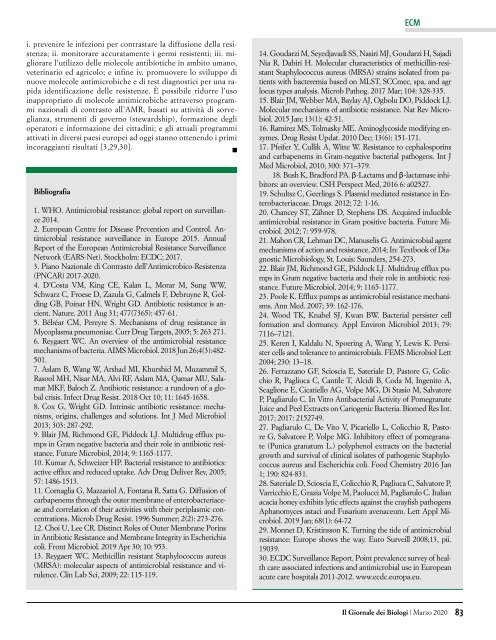You also want an ePaper? Increase the reach of your titles
YUMPU automatically turns print PDFs into web optimized ePapers that Google loves.
ECM<br />
i. prevenire le infezioni per contrastare la diffusione della resistenza;<br />
ii. monitorare accuratamente i germi resistenti; iii. migliorare<br />
l’utilizzo delle molecole antibiotiche in ambito umano,<br />
veterinario ed agricolo; e infine iv. promuovere lo sviluppo di<br />
nuove molecole antimicrobiche e di test diagnostici per una rapida<br />
identificazione delle resistenze. È possibile ridurre l’uso<br />
inappropriato di molecole antimicrobiche attraverso programmi<br />
nazionali di contrasto all’AMR, basati su attività di sorveglianza,<br />
strumenti di governo (stewardship), formazione degli<br />
operatori e informazione <strong>dei</strong> cittadini; e gli attuali programmi<br />
attivati in diversi paesi europei ad oggi stanno ottenendo i primi<br />
incoraggianti risultati [3,29,30].<br />
Bibliografia<br />
1. WHO. Antimicrobial resistance: global report on surveillance<br />
2014.<br />
2. European Centre for Disease Prevention and Control. Antimicrobial<br />
resistance surveillance in Europe 2015. Annual<br />
Report of the European Antimicrobial Resistance Surveillance<br />
Network (EARS-Net). Stockholm: ECDC; 2017.<br />
3. Piano Nazionale di Contrasto dell’Antimicrobico-Resistenza<br />
(PNCAR) 2017-2020.<br />
4. D’Costa VM, King CE, Kalan L, Morar M, Sung WW,<br />
Schwarz C, Froese D, Zazula G, Calmels F, Debruyne R, Golding<br />
GB, Poinar HN, Wright GD. Antibiotic resistance is ancient.<br />
Nature. 2011 Aug 31; 477(7365): 457-61.<br />
5. Bébéar CM, Pereyre S. Mechanisms of drug resistance in<br />
Mycoplasma pneumoniae. Curr Drug Targets, 2005; 5: 263 271.<br />
6. Reygaert WC. An overview of the antimicrobial resistance<br />
mechanisms of bacteria. AIMS Microbiol. 2018 Jun 26;4(3):482-<br />
501.<br />
7. Aslam B, Wang W, Arshad MI, Khurshid M, Muzammil S,<br />
Rasool MH, Nisar MA, Alvi RF, Aslam MA, Qamar MU, Salamat<br />
MKF, Baloch Z. Antibiotic resistance: a rundown of a global<br />
crisis. Infect Drug Resist. 2018 Oct 10; 11: 1645-1658.<br />
8. Cox G, Wright GD. Intrinsic antibiotic resistance: mechanisms,<br />
origins, challenges and solutions. Int J Med Microbiol<br />
2013; 303: 287-292.<br />
9. Blair JM, Richmond GE, Piddock LJ. Multidrug efflux pumps<br />
in Gram negative bacteria and their role in antibiotic resistance.<br />
Future Microbiol, 2014; 9: 1165-1177.<br />
10. Kumar A, Schweizer HP. Bacterial resistance to antibiotics:<br />
active efflux and reduced uptake. Adv Drug Deliver Rev, 2005;<br />
57: 1486-1513.<br />
11. Cornaglia G, Mazzariol A, Fontana R, Satta G. Diffusion of<br />
carbapenems through the outer membrane of enterobacteriaceae<br />
and correlation of their activities with their periplasmic concentrations.<br />
Microb Drug Resist. 1996 Summer; 2(2): 273-276.<br />
12. Choi U, Lee CR. Distinct Roles of Outer Membrane Porins<br />
in Antibiotic Resistance and Membrane Integrity in Escherichia<br />
coli. Front Microbiol. 2019 Apr 30; 10: 953.<br />
13. Reygaert WC. Methicillin resistant Staphylococcus aureus<br />
(MRSA): molecular aspects of antimicrobial resistance and virulence.<br />
Clin Lab Sci, 2009; 22: 115-119.<br />
14. Goudarzi M, Seyedjavadi SS, Nasiri MJ, Goudarzi H, Sajadi<br />
Nia R, Dabiri H. Molecular characteristics of methicillin-resistant<br />
Staphylococcus aureus (MRSA) strains isolated from patients<br />
with bacteremia based on MLST, SCCmec, spa, and agr<br />
locus types analysis. Microb Pathog. 2017 Mar; 104: 328-335.<br />
15. Blair JM, Webber MA, Baylay AJ, Ogbolu DO, Piddock LJ.<br />
Molecular mechanisms of antibiotic resistance. Nat Rev Microbiol.<br />
2015 Jan; 13(1): 42-51.<br />
16. Ramirez MS, Tolmasky ME. Aminoglycoside modifying enzymes.<br />
Drug Resist Updat. 2010 Dec; 13(6): 151-171.<br />
17. Pfeifer Y, Cullik A, Witte W. Resistance to cephalosporins<br />
and carbapenems in Gram-negative bacterial pathogens. Int J<br />
Med Microbiol, 2010; 300: 371–379.<br />
18. Bush K, Bradford PA. β-Lactams and β-lactamase inhibitors:<br />
an overview. CSH Perspect Med, 2016 6: a02527.<br />
19. Schultsz C, Geerlings S. Plasmid mediated resistance in Enterobacteriaceae.<br />
Drugs. 2012; 72: 1-16.<br />
20. Chancey ST, Zähner D, Stephens DS. Acquired inducible<br />
antimicrobial resistance in Gram positive bacteria. Future Microbiol.<br />
2012; 7: 959-978.<br />
21. Mahon CR, Lehman DC, Manuselis G. Antimicrobial agent<br />
mechanisms of action and resistance, 2014; In: Textbook of Diagnostic<br />
Microbiology, St. Louis: Saunders, 254-273.<br />
22. Blair JM, Richmond GE, Piddock LJ. Multidrug efflux pumps<br />
in Gram negative bacteria and their role in antibiotic resistance.<br />
Future Microbiol. 2014; 9: 1165-1177.<br />
23. Poole K. Efflux pumps as antimicrobial resistance mechanisms.<br />
Ann Med. 2007; 39: 162-176.<br />
24. Wood TK, Knabel SJ, Kwan BW. Bacterial persister cell<br />
formation and dormancy. Appl Environ Microbiol 2013; 79:<br />
7116–7121.<br />
25. Keren I, Kaldalu N, Spoering A, Wang Y, Lewis K. Persister<br />
cells and tolerance to antimicrobials. FEMS Microbiol Lett<br />
2004; 230: 13–18.<br />
26. Ferrazzano GF, Scioscia E, Sateriale D, Pastore G, Colicchio<br />
R, Pagliuca C, Cantile T, Alcidi B, Coda M, Ingenito A,<br />
Scaglione E, Cicatiello AG, Volpe MG, Di Stasio M, Salvatore<br />
P, Pagliarulo C. In Vitro Antibacterial Activity of Pomegranate<br />
Juice and Peel Extracts on Cariogenic Bacteria. Biomed Res Int.<br />
2017; 2017: 2152749.<br />
27. Pagliarulo C, De Vito V, Picariello L, Colicchio R, Pastore<br />
G, Salvatore P, Volpe MG. Inhibitory effect of pomegranate<br />
(Punica granatum L.) polyphenol extracts on the bacterial<br />
growth and survival of clinical isolates of pathogenic Staphylococcus<br />
aureus and Escherichia coli. Food Chemistry 2016 Jan<br />
1; 190: 824-831.<br />
28. Sateriale D, Scioscia E, Colicchio R, Pagliuca C, Salvatore P,<br />
Varricchio E, Grazia Volpe M, Paolucci M, Pagliarulo C. Italian<br />
acacia honey exhibits lytic effects against the crayfish pathogens<br />
Aphanomyces astaci and Fusarium avenaceum. Lett Appl Microbiol.<br />
2019 Jan; 68(1): 64-72<br />
29. Monnet D, Kristinsson K. Turning the tide of antimicrobial<br />
resistance: Europe shows the way. Euro Surveill 2008;13, pii.<br />
19039.<br />
30. ECDC Surveillance Report. Point prevalence survey of health<br />
care associated infections and antimicrobial use in European<br />
acute care hospitals 2011-2012. www.ecdc.europa.eu.<br />
<strong>Il</strong> <strong>Giornale</strong> <strong>dei</strong> <strong>Biologi</strong> | Marzo 2020<br />
83

















